11 Main customer data platform (CDP) use cases for marketers
Customer data platforms (CDPs) are powerful tools for marketers who want to understand and improve their customers’ experience. Their abilities to aggregate data from disparate sources and resolve omnichannel identities are crucial, especially with today’s complex customer journeys.
But while data unification, 360-degree customer profile creation, and segmentation are the most popular CDP use cases, they’re far from the only ones.
Updated on 30 Sep 2025
CDPs can also help you in lots of other scenarios, including cross-channel personalization, journey orchestration, workflow optimization, advanced analytics, and more. There are also different types of CDPs, some of which are more suitable for certain use cases than others.
In this guide, you’ll learn about the 11 key CDP use cases for marketers. We’ll start with foundational use cases like data unification and move on to more niche ones, like churn prevention, acquisition cost optimization, and more.
We’ll also use Insider — our Campaign CDP and cross-channel personalization platform — to explore real-life examples of these use cases and show you how you can implement them in your organization.
But before we dive in, let’s start with a quick refresher on what CDPs are, how they work, and the different types of CDPs available on the market.
Insider’s Actionable CDP helps you bring all your customer data from online and offline sources into one place to create connected customer experiences that drive conversions, revenue, and retention. Request a demo or see how it works for yourself.
Customer data platforms: What they are and how they work
Customer data platforms (CDPs) are software solutions that consolidate customer data spread across various systems into a single unified database.
They create 360-degree profiles of each customer, which enables brands to understand their customers’ journeys, segment their audiences, and power their marketing initiatives with reliable data.
CDPs work by connecting to various sources and aggregating customer data from them in one place. Typical sources include analytics tools, customer relationship management systems (CRMs), content management systems (CMSs), point-of-sale (POS) devices, APIs, customer service solutions, and email marketing platforms.
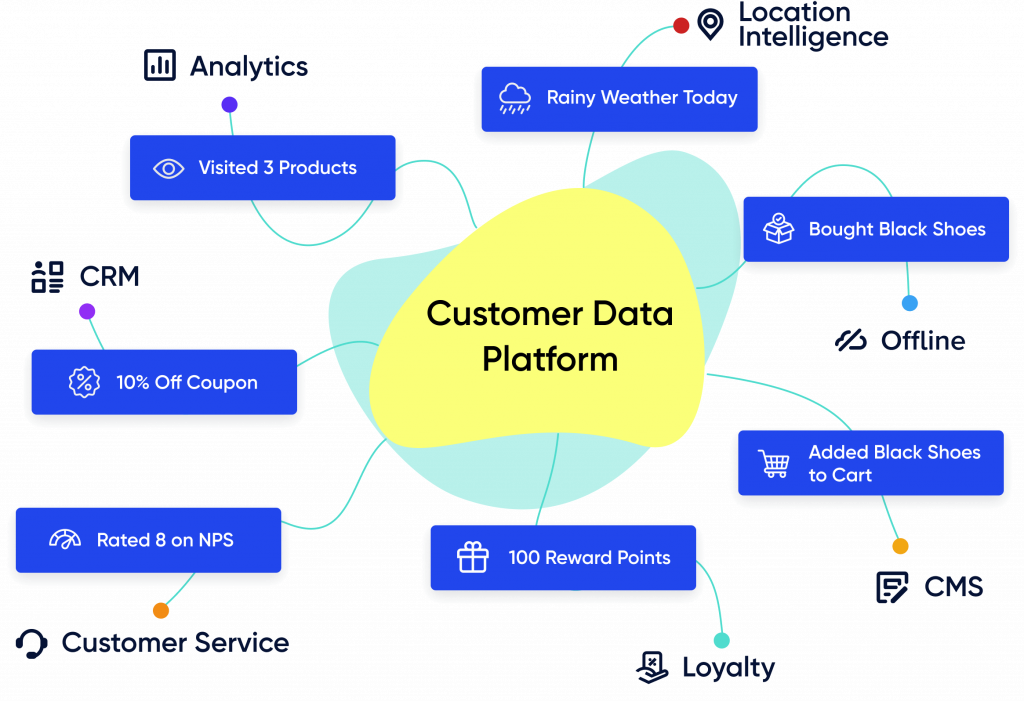
As we explained in our guide to the 8 best CDPs, data aggregation, identity resolution, and segmentation capabilities are the core capabilities of any CDP.
However, CDPs have different areas of specialization beyond those foundational features. We can organize them into two broad categories:
- Campaign (or Actionable) CDP. These CDPs have built-in ways to activate your data across channels. For example, Insider’s Actionable CDP can consolidate your customer data. Then, our platform’s 12+ native channels, personalization capabilities, and automation features enable you to use that data for your marketing efforts without passing it on to downstream platforms.
- Data and Analytics CDPs. These CDPs have additional features for more technical teams and use cases, like data governance, data cleaning, data visualization, and schema management. More traditional CDPs, like Segment and mParticle, can be considered a part of this category. They don’t have as many features for data activation, so they need to be integrated and pass their data to downstream platforms, like email and SMS marketing software, personalization tools, and so on.
11 CDP use cases for driving efficiency, revenue, retention, and more
As you can see, CDPs can be very different from one another depending on the category they fall into. This means that some of the use cases we explore below are better suited for a certain type of CDP. For example:
- Use cases 1 — 5 are applicable to pretty much all CDPs.
- Use case 6 falls more in the domain of Data and Analytics CDPs.
- Use cases 7 — 11 are more suitable for Campaign CDPs since most Data and Analytics CDPs need to be integrated with third-party systems to implement them.
Note: If you want even more examples, check out our CDP use case explorer. It lets you break down 50+ CDP use cases by data source and explore our CDP in an interactive way.
#1 Data unification
This is the quintessential CDP use case. You take a disconnected technology stack, pull valuable customer data from each system, and get a unified customer database in one convenient place.
For example, you can use a Campaign CDP like Insider to pull data from:
- eCommerce platforms, like BigCommerce, Shopify, and Magento.
- Data and Analytics CDPs, like Segment and Tealium.
- Analytics solutions, like Contentsquare and Mixpanel.
- APIs.
- And much more.
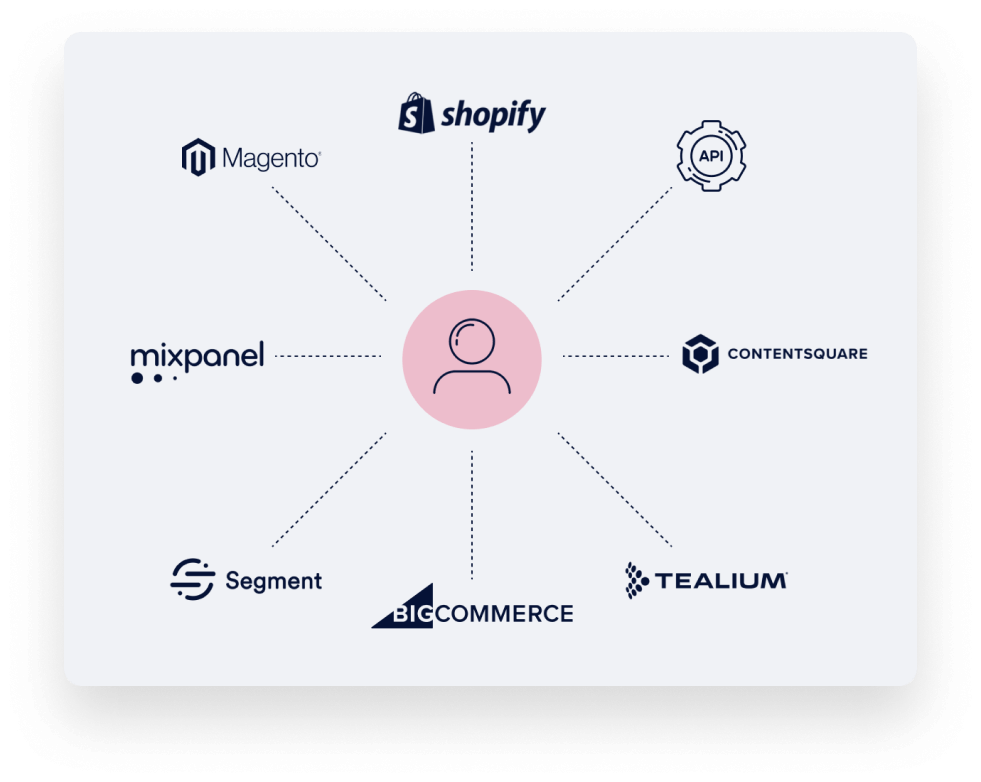
This use case is partly the reason why all CDPs have a large number of integrations — they support the foundational CDP use case. For instance, Insider integrates with hundreds of solutions across 20+ categories, like CDPs, CRMs, online ad tools, loyalty management platforms, feedback and survey tools, and many more.
#2 Identity resolution and 360-degree customer profiles
Identity resolution is the process of combining user behaviors and characteristics across all channels, devices, and systems. It lets brands tie their disconnected data into an accurate picture of each customer’s journey.
The results of this process are unified customer profiles that give brands a complete view of their customers’ experience. For example, the screenshot below shows a 360-degree customer profile in Insider’s CDP:
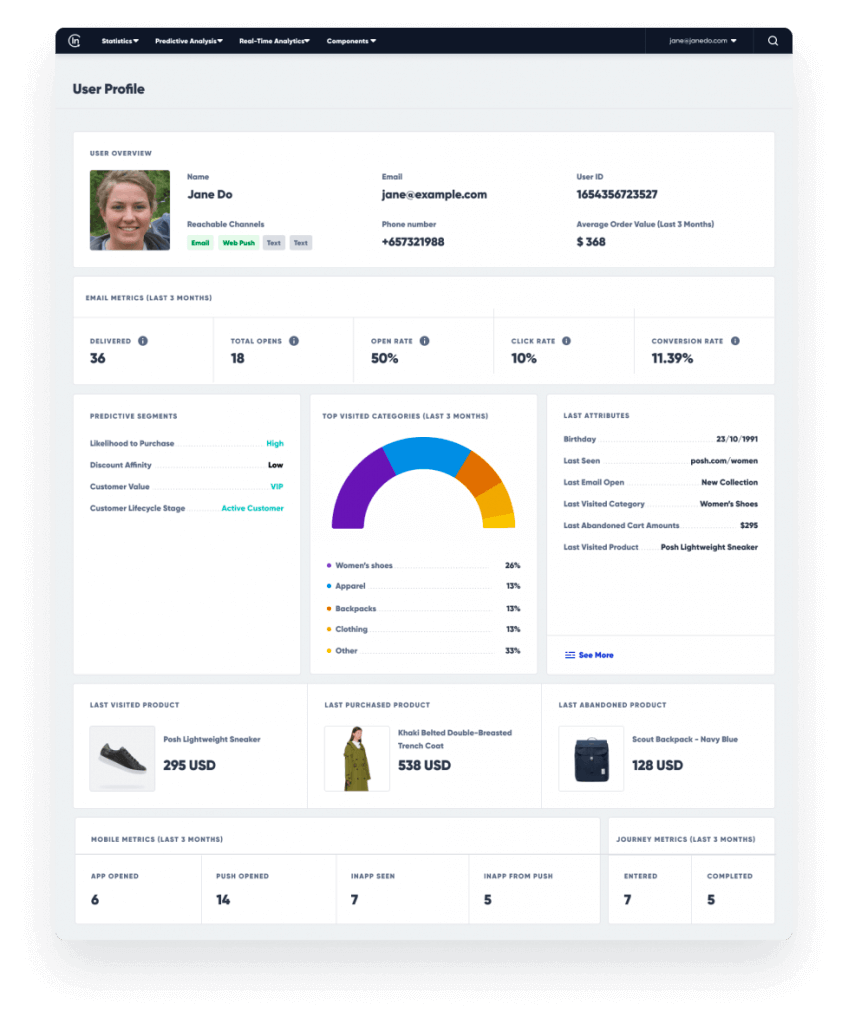
These profiles are invaluable for marketers as they contain everything they need to run successful campaigns, including customers’:
- Names, emails, phone numbers, and other contact details.
- Locations and demographic information (if available).
- Last purchased, visited, and abandoned products.
- Interactions with the brand across all touchpoints.
- Predictive characteristics, such as how likely they are to buy or churn.
With Data and Analytics CDPs, these profiles can be passed to downstream systems for activation. If you’re using a Campaign CDP, you can move on to the activation process directly without relying on third-party solutions.
#3 Streamlining of workflows and operations
With so many different solutions in a modern marketing stack, customer data gets locked away in disparate systems, like:
- Analytics tools.
- Personalization tools.
- Email marketing platforms.
- WhatsApp marketing tools.
- And more.
This creates data silos and prevents marketing teams from getting a clear picture of their customers’ journeys. It also forces them to constantly jump between systems and pour resources into building and maintaining expensive integrations.
CDPs overcome this problem by becoming a single source of truth for all customer data. Plus, their extensive integrations guarantee smooth data flows between the different parts of your marketing stack.
Once you’ve set up a CDP, you don’t have to constantly go back and forth between systems or manually transfer data between tools and spreadsheets. This can save you tons of time, effort, and resources.
Also, if you’re using a Campaign CDP with broad channel support, you can consolidate your marketing stack into a single platform and work even more efficiently. For example, Spotlight Retail Group used Insider’s CDP to consolidate their data and marketing stack, which enabled their team to launch campaigns in just six days — an 80% reduction from the original launch times.
#4 Accurate customer segmentation
Segmentation is the process of dividing potential customers into groups based on similar interests, behaviors, and characteristics. It enables marketers to understand different customer groups and tailor their strategies accordingly.
Since CDPs aggregate all relevant customer data in one place, they’re ideal for segmentation. You can be sure that you’re segmenting audiences based on the entirety of their interactions with your brand, without missing valuable customer information.
That’s why all CDPs have segmentation capabilities. For example, with Insider, you can start the segmentation process with pre-made audiences of users who:
- Made a purchase within a specified period of time.
- Abandoned their carts (or a product page on your site).
- Interacted with your brand on a specific channel, like email, SMS, or WhatsApp.
- And more shown below.
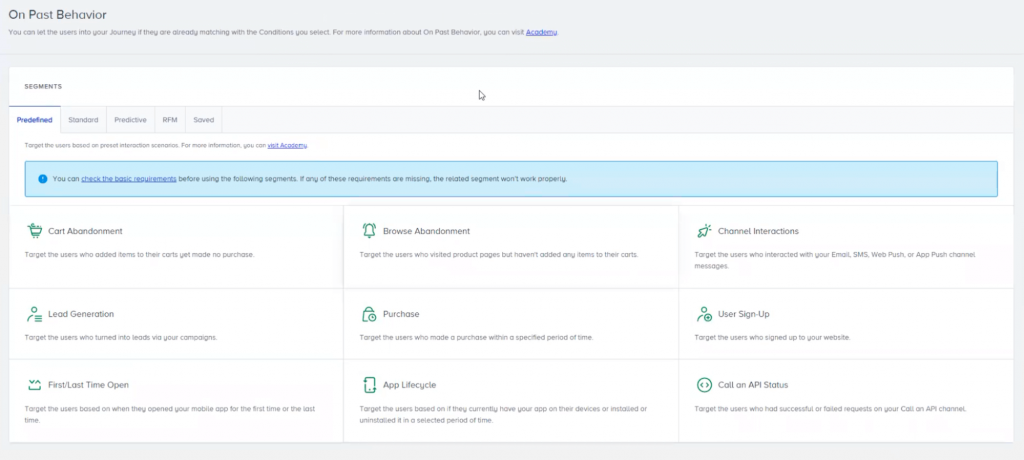
These target audiences are automatically created, so you don’t have to waste time building them from scratch.
Then, you can choose from 120+ behaviors, preferences, and traits to home in on the best customers for each campaign. For instance, you can target users based on their devices, locations, affinity toward certain attributes (colors, sizes, price ranges, and so on), events they’ve performed, and much more.
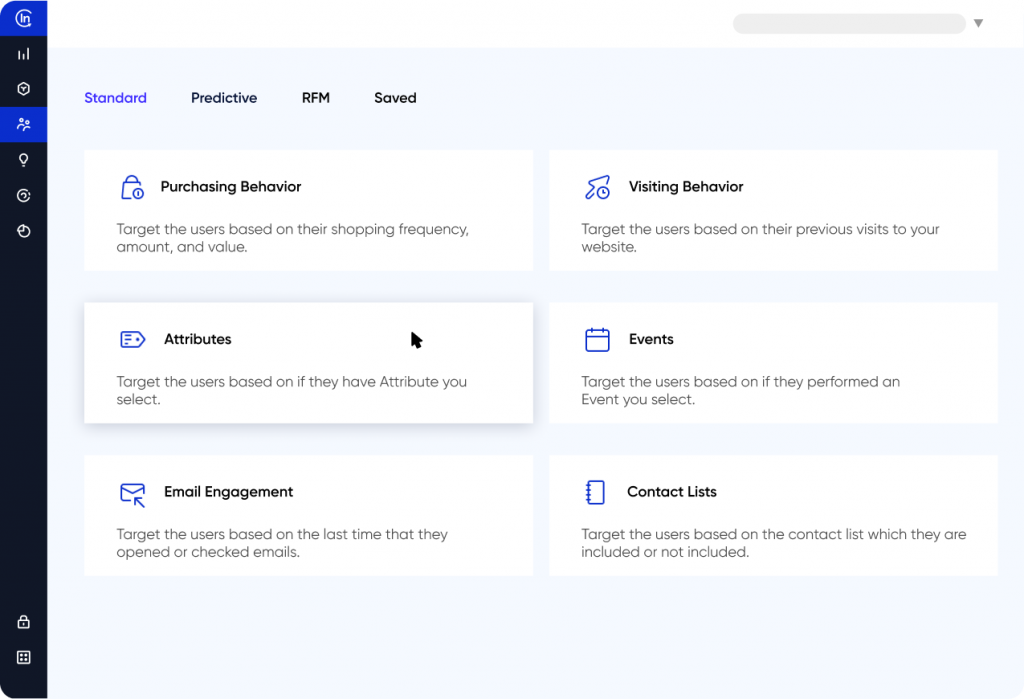
These versatile segmentation options ensure you can always find the right audiences for your campaigns. You can even enrich your segments with AI-powered predictions, as we’ll discuss in the next section.
#5 AI-powered behavioral predictions
The advances in AI and machine learning over the last few years have enabled CDPs to offer more precise segmentation and targeting options with behavioral predictions. For example, Insider enables you to target users based on their:
- Projected customer lifetime value (LTV).
- Likelihood to purchase or churn.
- Discount or attribute affinity.
- Interest clusters.
- And more.
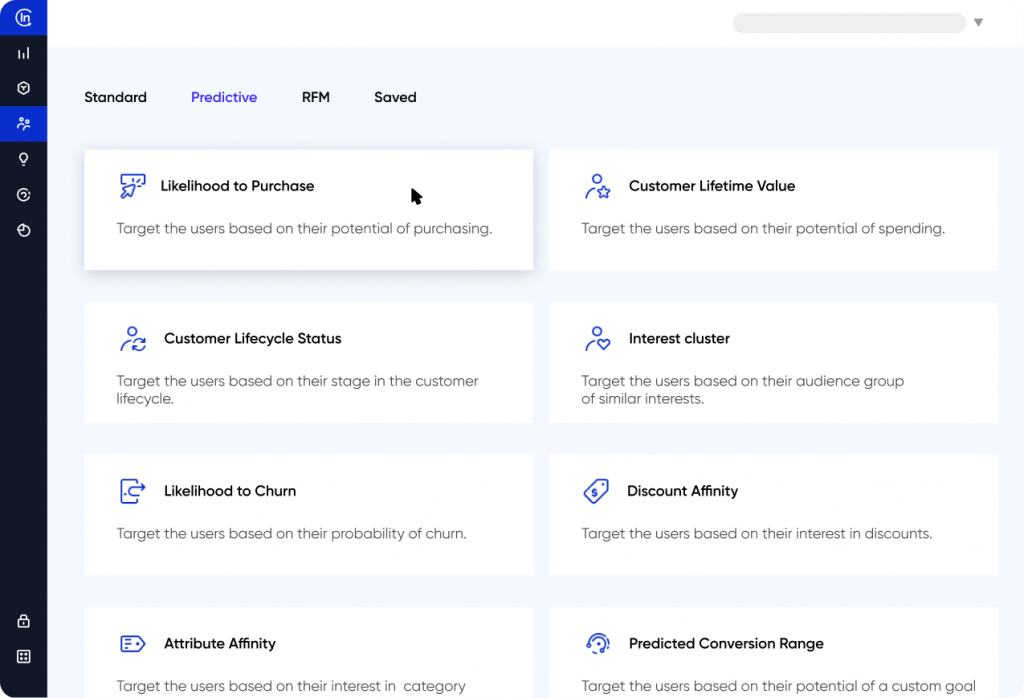
You even have a dedicated analytics dashboard where you can get various predictive insights about your audience.
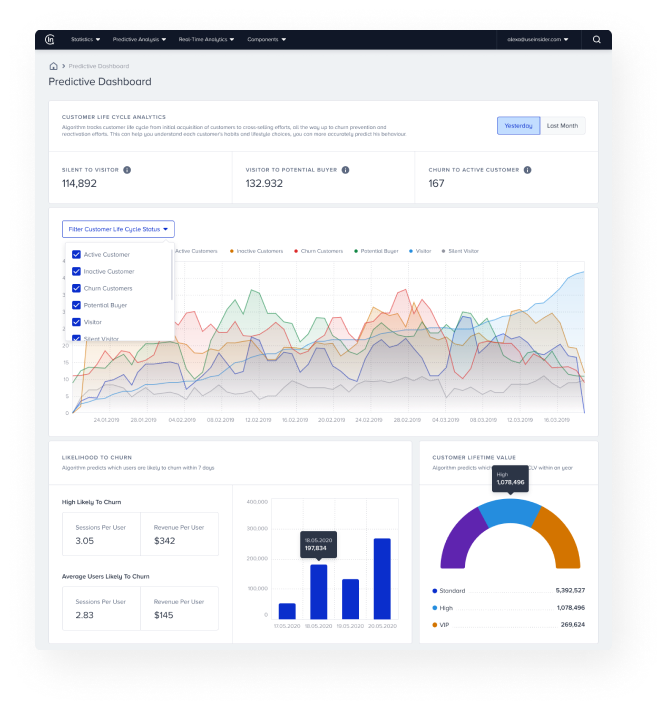
These predictive insights open up a whole new world of possibilities for running successful marketing campaigns. For instance:
- You can run discount campaigns only for users with a high discount affinity. That way, you won’t waste discounts on people who would’ve bought a product at its regular price.
- You can show your best offers to customers with the highest potential LTV. This is a great way to make your high-value customers feel special and appreciated by your brand.
- You can use online ads to target people with a high likelihood of purchasing. US. Polo Assn. used Insider’s likelihood to purchase algorithm to target users with the highest buying intent via online ads. This resulted in a conversion rate increase of 311%, a customer acquisition cost decrease of 58%, and a 135% boost in return on ad spend (ROAS).
#6 Customer journey analytics
Having all your customer data is a great foundation for analyzing your customers’ journeys. That’s why all CDPs have some form of analytics capabilities built in.
For example, with Insider, you have a fully customizable audience analytics dashboard that shows you the number of unknown users, channel reachability, funnel completions, and more.
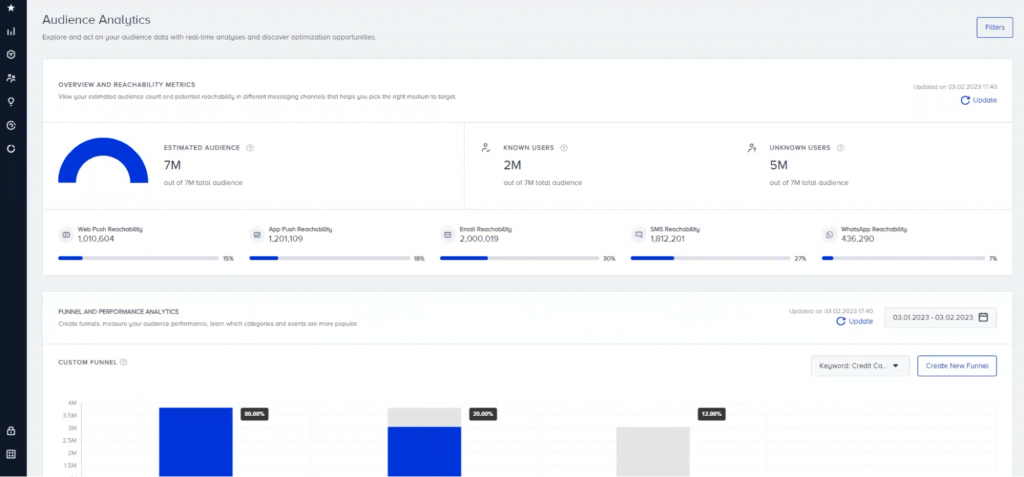
You can also build custom dashboards with key metrics for various teams and stakeholders. For example:
- Mobile marketers can look at customer engagement across channels, like SMS, WhatsApp, or mobile push.
- Website marketers can dive deep into how many conversions their website personalization tactics are bringing in.
- Lifecycle marketers can analyze funnels, campaigns, and other journey flows through the entire customer lifecycle.
- C-level executives can look at higher-level metrics, like revenue, acquisition costs, and LTV.
For advanced analytics use cases, a Data or Analytics CDP, like mParticle or Tealium, can provide even more useful capabilities. Alternatively, you can also integrate a Campaign CDP with a dedicated analytics platform, like Mixpanel and Amplitude, to get the best out of both worlds.
#7 Cross-channel journey orchestration and automation
Journey orchestration is the process of creating consistent and engaging experiences across all customer touchpoints. CDPs are an ideal foundation here because the whole process relies heavily on accurate customer data.
This is another area where Campaign CDPs excel, as they usually have:
- Broad channel support.
- Built-in customer journey builders.
- Lots of features for automating and optimizing each journey.
In contrast, Data and Campaign CDPs usually have to pass their data on to other platforms where marketers can deploy their journeys.
For example, a Campaign CDP like Insider gives you access to 12+ native channels, including websites, mobile apps, email, push notifications, SMS, WhatsApp, and more.
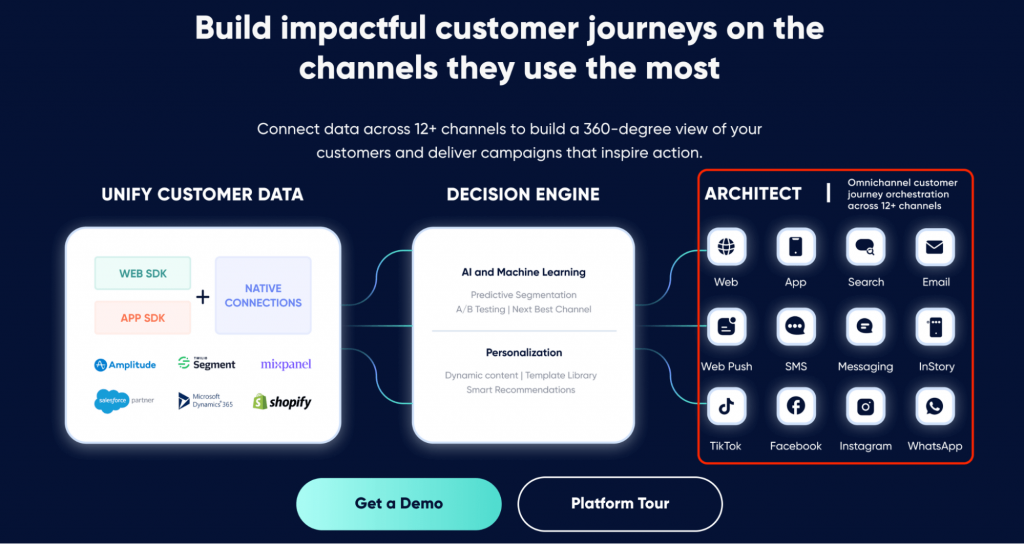
You can use Architect — our cross-channel journey builder — to build and automate personalized journeys across all these channels using a simple drag-and-drop editor. These journeys can contain dynamic and engaging content by leveraging data, like names, last-viewed products, locations, and other attributes stored in your CDP.
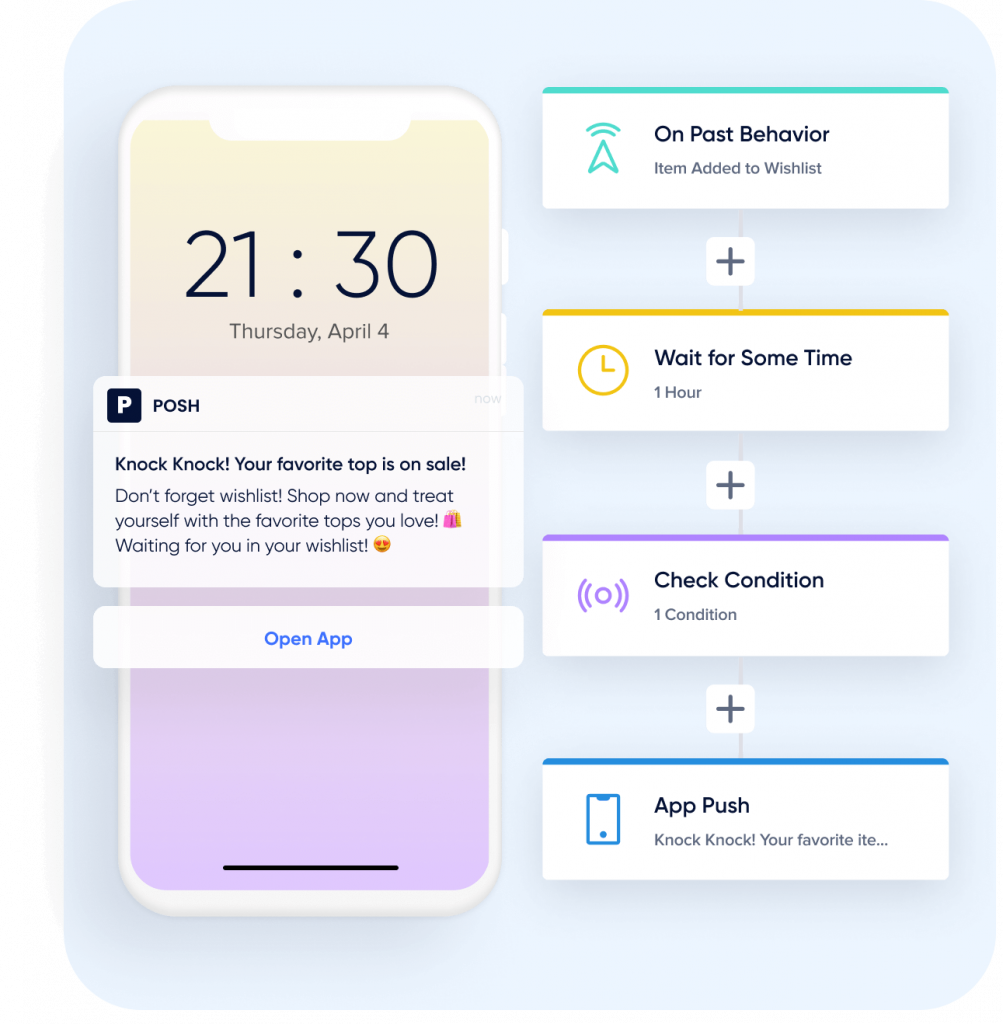
Overall, you can use Architect to run everything from simple email onboarding sequences to complex cross-sell and upsell campaigns across all supported channels.
Insider’s AI-powered algorithms can also analyze your unified data and automatically optimize each journey with:
- Send-Time Optimization (STO). This feature automatically picks the ideal time to send each message. It does that by examining each recipient’s behavioral patterns to uncover the optimal send time.
- A/B Test Winner-Autoselection. Insider comes with built-in A/B testing capabilities for experimenting with subject lines, images, or entire journey flows. The Winner-Autoselection automatically optimizes journeys based on the results of your A/B tests, which saves you tons of time compared to manually reviewing each experiment and adjusting each journey.
- Next-Best Channel Predictions. This feature automatically selects the right touchpoint to try next, based on users’ behaviors and preferences. All you have to do is enable it and add your channels with the drag-and-drop editor.
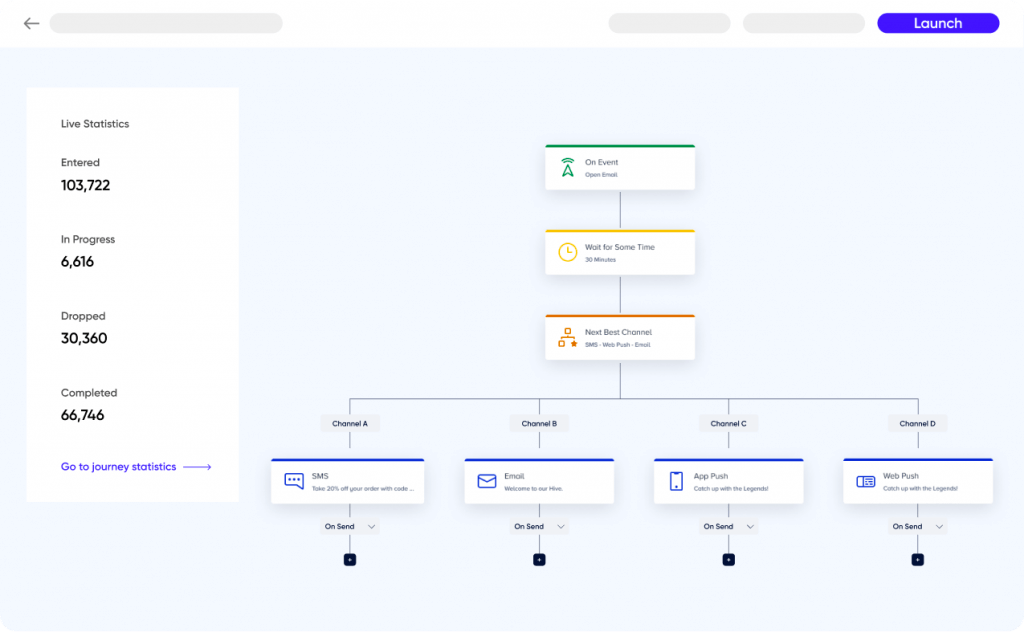
Fashion brand NA-KD uses Insider’s CDP and omnichannel journey orchestration to unify their data and deliver unique experiences to every customer. They rely on Architect to orchestrate these journeys across their website, mobile app, email, SMS, and push notifications.
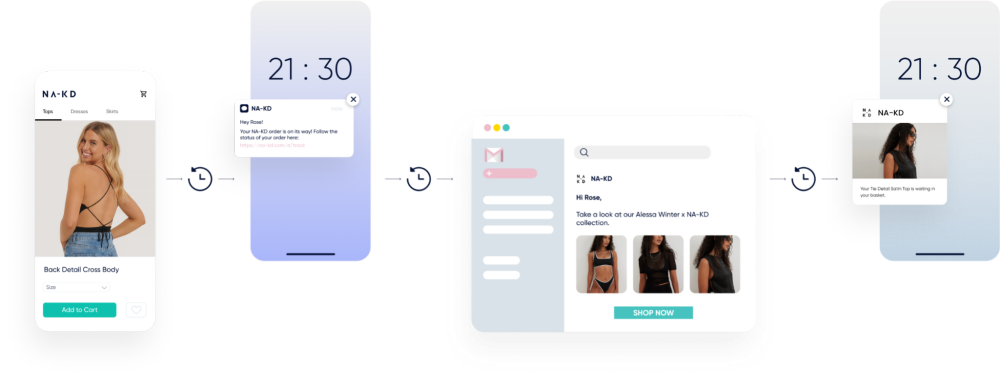
Thanks to these capabilities, NA-KD saw a 25% uplift in LTV and achieved a 72x return on investment (ROI) within 12 months of working with Insider.
For even more details and examples, check out our guides on:
#8 Advanced personalization across all touchpoints
Personalization is the process of providing each customer with tailored content, messaging, and product recommendations at every stage of their journeys. Like journey orchestration, personalization is highly dependent on accurate customer data, making CDPs a must for marketers looking to individualize each customer’s experience.
For example, once you’ve unified your data with Insider, you can use our platform to start tailoring each customer’s experience on every touchpoint, including:
- Your website and mobile app. Insider’s personalization engine can enable you to personalize every element of your site or app — including categories, banners, pop-ups, and product recommendations — to each customer’s behaviors, interests, and preferences. This is crucial for increasing conversion rates and making the most out of your marketing spend.
- External channels, like email, push notifications SMS, WhatsApp, Facebook Messenger, and more. For instance, you can automatically scale your personalized product recommendations across all channels. This is a great way to ensure a consistent experience throughout the entire customer journey.
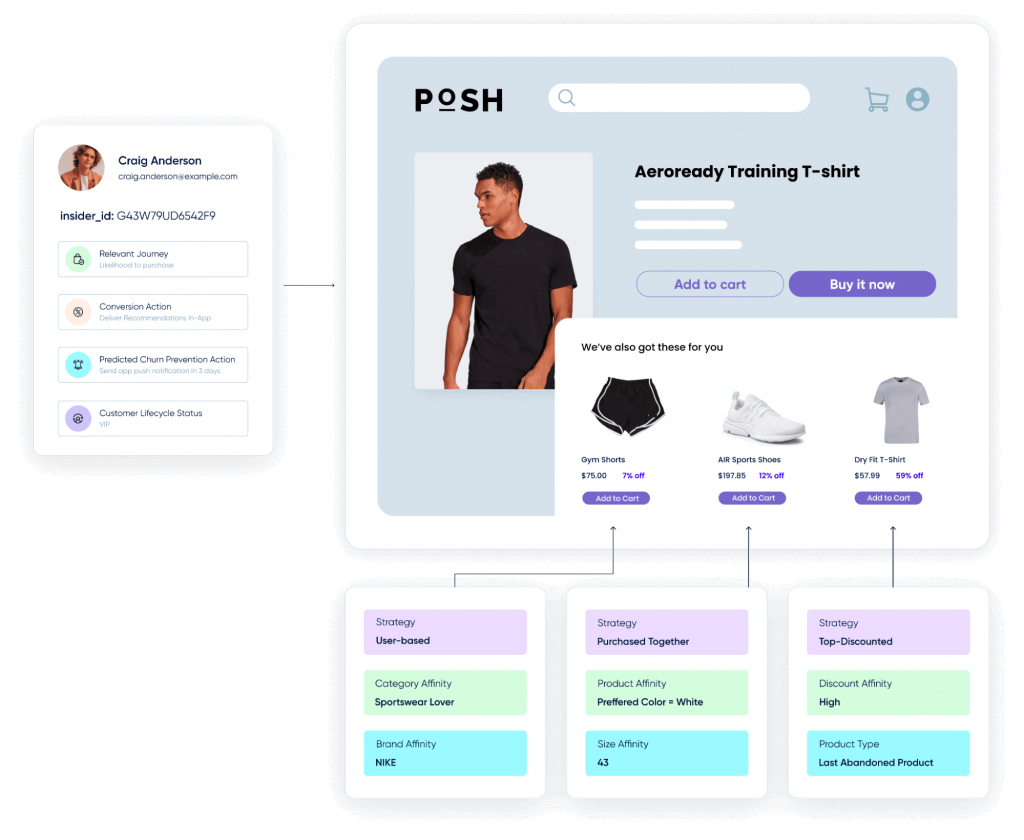
Check out our guide to creating a personalized customer experience for a deeper dive into this topic.
#9 Customer acquisition cost (CAC) optimization
Rising CACs have been one of the biggest problems for marketing teams over the last few years. That’s why it’s critical to convert anonymous visitors into customers as quickly and cheaply as possible.
The traditional way to do this is by reaching customers who browsed your site with retargeting ads on social media and search engines. However, these ads have gotten more and more expensive, making this strategy less cost-effective over time.
Fortunately, CDPs can help mitigate this issue. Some CDPs like Insider can create profiles for anonymous visitors similar to the ones for known customers. While these profiles don’t contain persistent identifiers (like users’ names, contact info, or CRM IDs), they still show the products, categories, and other attributes visitors are interested in.
With this information, you can personalize their experience in real time. For example, you can show them different banners, categories, and product recommendations based on their interests and preferences, which can drastically reduce the time it takes to turn them into buyers.
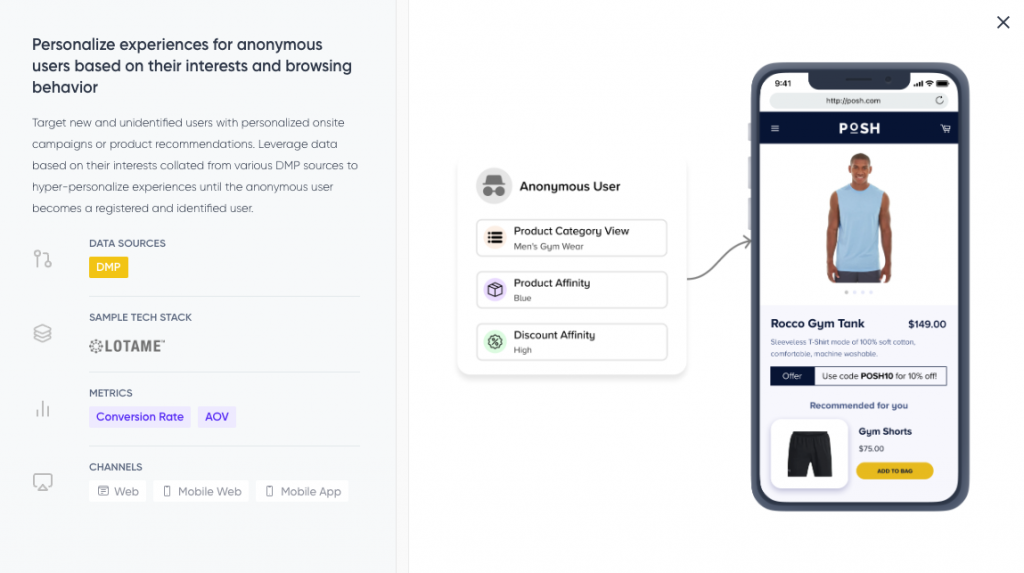
You can even send them personalized web push notifications based on the products and categories they’ve recently browsed, shown interest in, or abandoned in their carts. This is one of the most cost-effective ways to bring back visitors to your site, as it doesn’t rely on expensive performance ads.
For example, Carrefour’s marketing team used Insider’s web push notifications to engage cart abandoners, which helped them secure an additional $11,000 of revenue and a conversion rate uplift of 350%.
#10 Online-offline data intelligence
If your business has a physical presence, customers likely buy products, ask about upcoming collections, sign up for live events, and perform many other actions there that are key parts of their journeys. This means that tons of useful data likely gets generated there every day.
CDPs allow you to consolidate this offline data alongside customers’ online data. For example, you can pull data from your POS devices to get in-store transactions into each customer profile. With an Actionable CDP like Insider, you can even send customers personalized push notifications whenever they walk near your physical stores to entice them to go in.
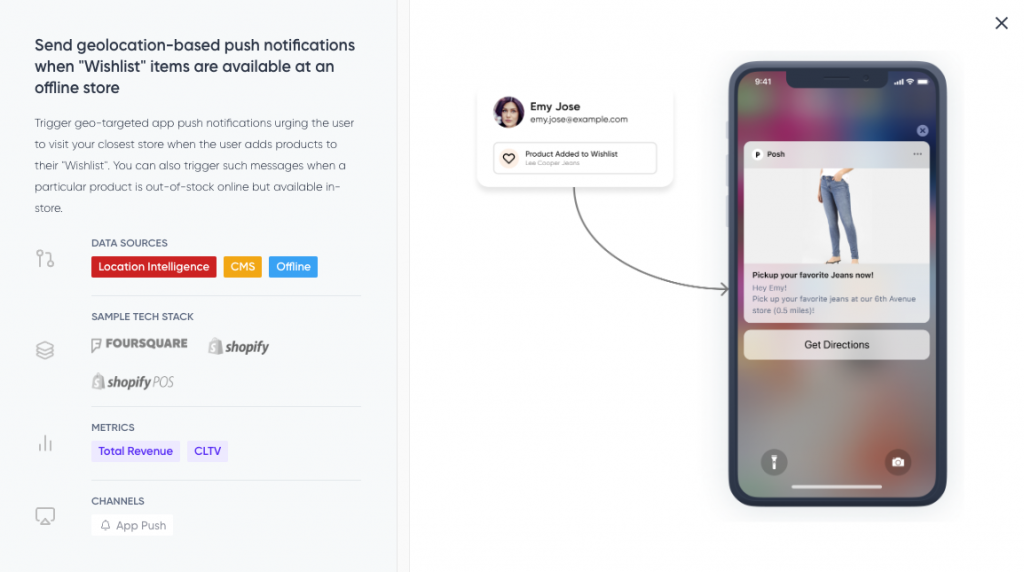
#11 Churn prevention
CDPs can be instrumental in your strategy for reducing churn and improving retention. Using AI, some CDPs can analyze your data, pinpoint customers who are close to churning, and enable you to prevent that.
For example, Insider can help you prevent churn by:
- Targeting customers with a likelihood of churning with special offers and discounts.
- Showing you where the biggest activity drop-offs occur in the customer journey so that you can reach out with personalized messaging, content, and product recommendations at the right moments.
- Placing low net promoter score (NPS) customers on a suppression list to avoid contact fatigue (and, as a result — churn).
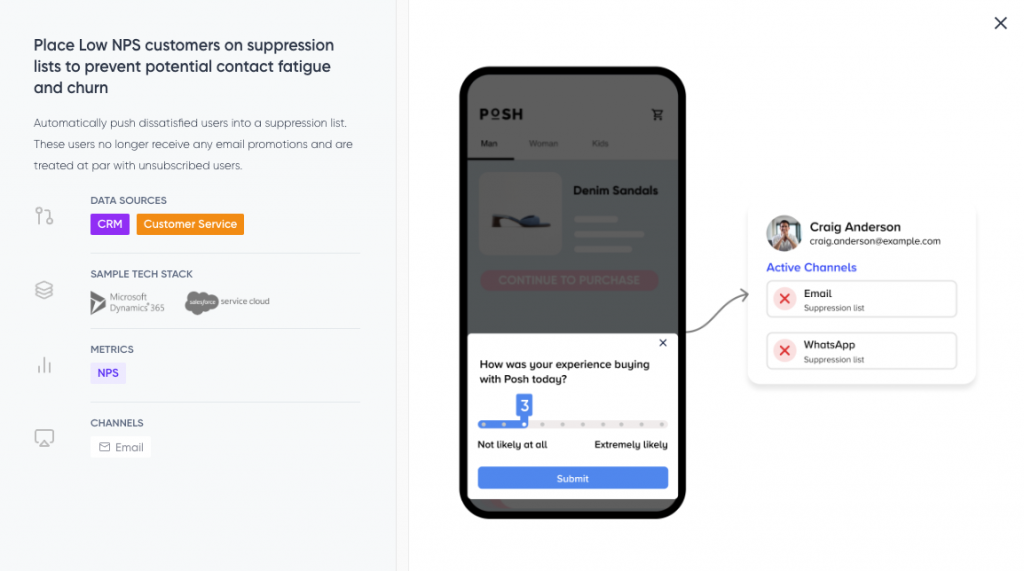
Just like personalization, these churn prevention tactics are crucial for maximizing revenue and marketing budget over the long term.
Consolidate and activate your customer data with Insider
Insider is ranked as the best and easiest-to-use CDP on G2.
Our CDP can aggregate data from any online or offline source — including CRMs, APIs, POS devices, analytics tools, customer service software, and even other CDPs — to give you accurate and actionable 360-customer profiles.
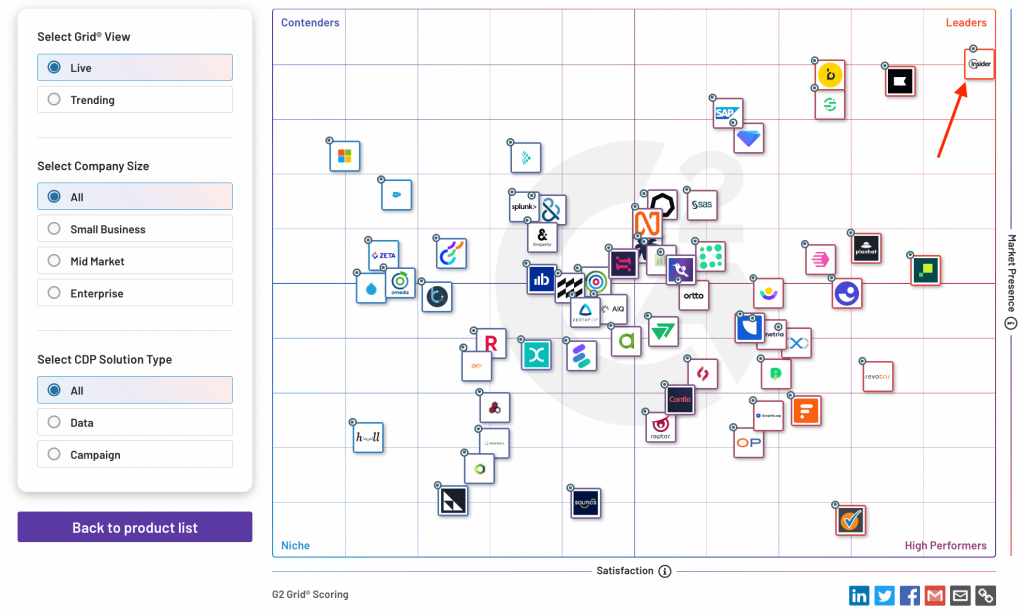
Our support team, which has the highest possible user satisfaction score of 100/100, will help you set up the platform, get the right data into it, and use it to drive revenue.
However, Insider isn’t just a CDP. Our platform also tops G2’s reports as the #1 leader in six categories, including mobile marketing software, personalization software, and personalization engines.
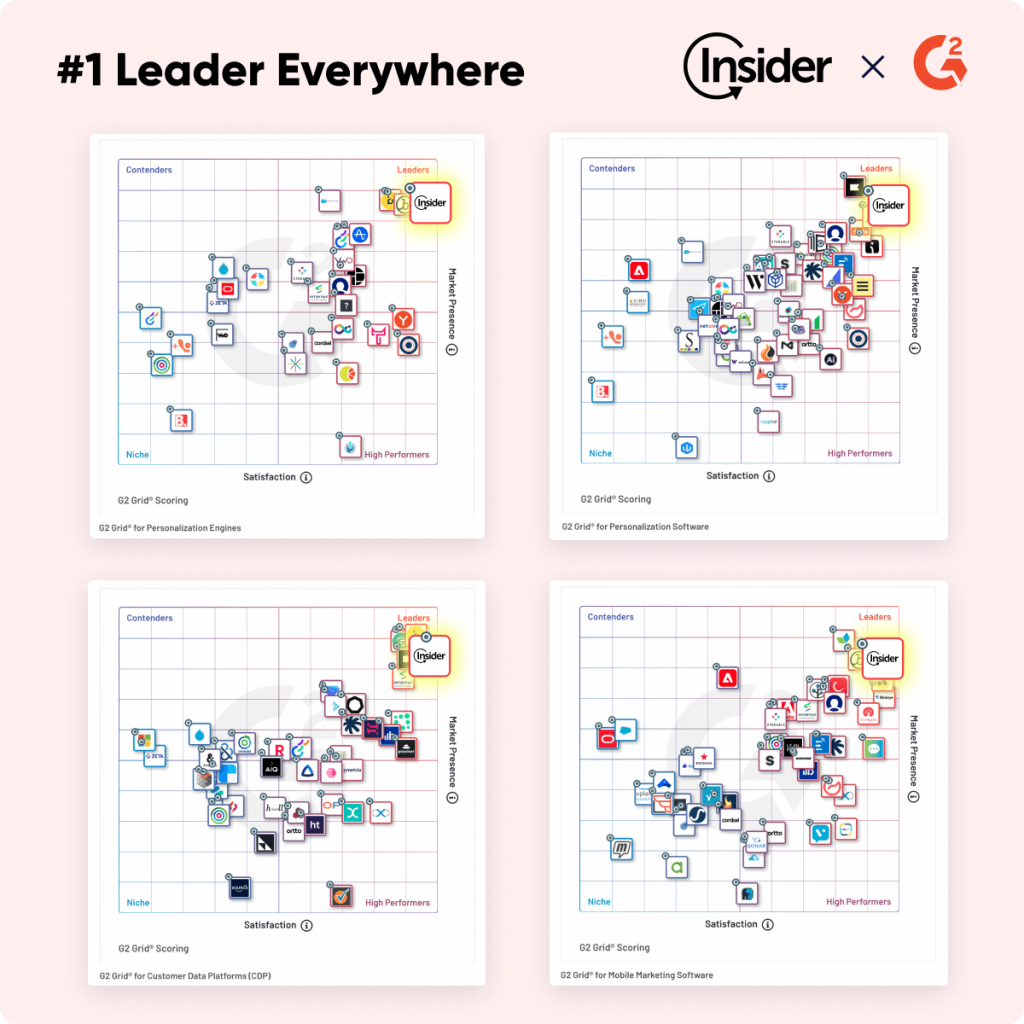
This means you can use Insider for a lot more than data consolidation, identity resolution, and segmentation. Our enterprise marketing platform can help you:
- Predict behaviors with an AI-powered intent engine, including how likely different audience segments are to buy or churn, how likely they are to respond to discounts, and how much they’re projected to spend.
- Deliver personalized experiences to customers on every touchpoint — from your website and mobile app to channels like email, SMS, WhatsApp, web push, and more.
- Automatically provide customers with the right content, messaging, and product recommendations on the right channels, at the right times.
- Be more productive and work more efficiently with a suite of AI-powered tools (called Sirius AI™). These tools can generate copy and images, create highly targeted segments, build and optimize journeys, and much more.
For more details on how Insider can help you make the most of your marketing efforts and budget, click here to schedule a free demo with our team.
Frequently asked questions (FAQs) about CDP use cases
The most common use cases for CDPs are customer data unification, segmentation, identity resolution, and data management. Brands can also use CDP providers to analyze, clean, and transform their datasets and comply with regulations like GDPR or CCPA.
B2B companies can use CDPs to consolidate their customer data (including account- and company-level data, which is crucial in B2B), overcome data silos, and keep track of prospects’ and customers’ journeys in one place.
CDPs are built to aggregate all customer data, while CRMs store only customer interaction data, like emails, support tickets, sales demos, and contracts. This makes CDPs more flexible as they can store all the data CRMs can, plus other first-party data, second-party data, and third-party data that doesn’t stem from customer interactions.



















